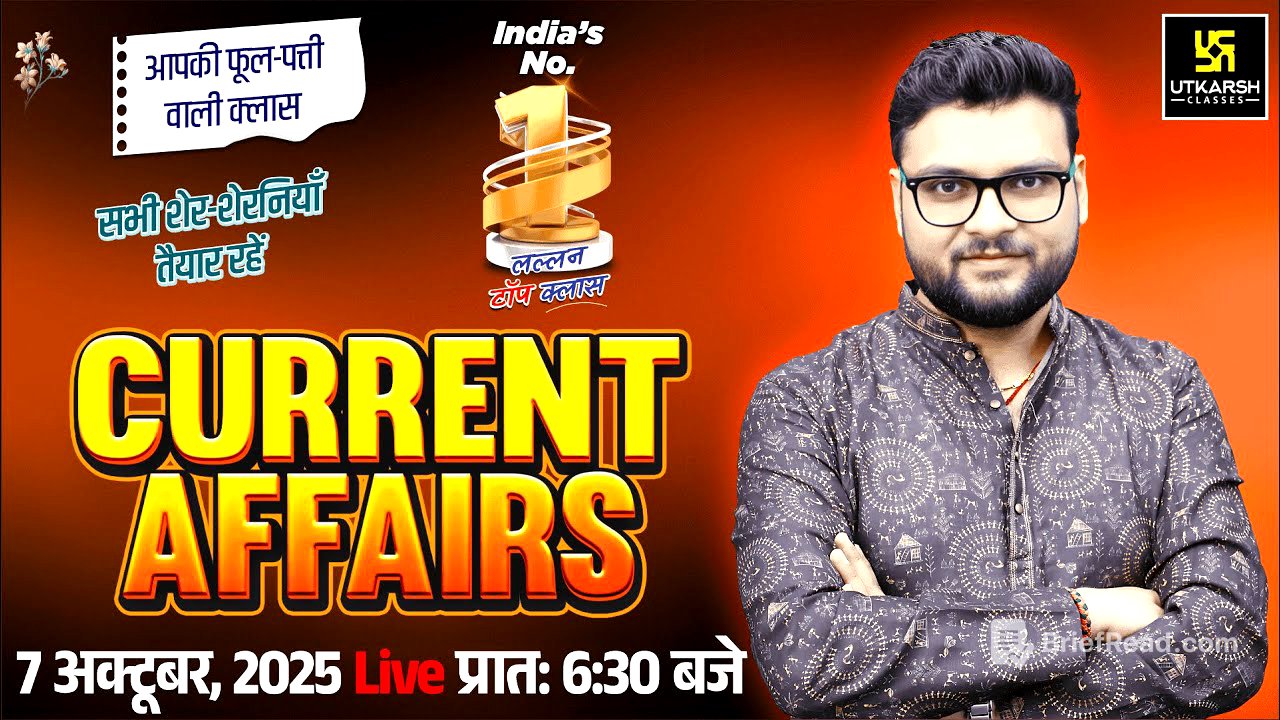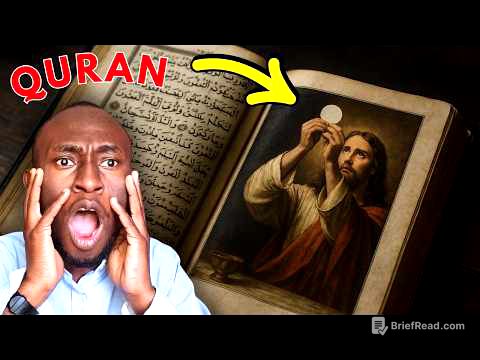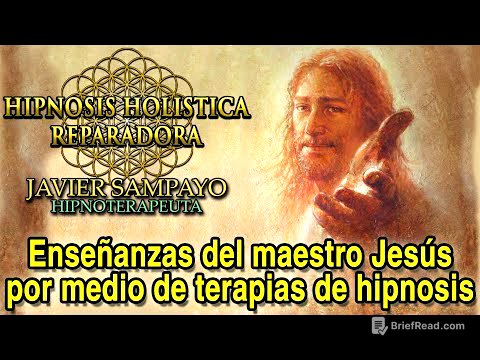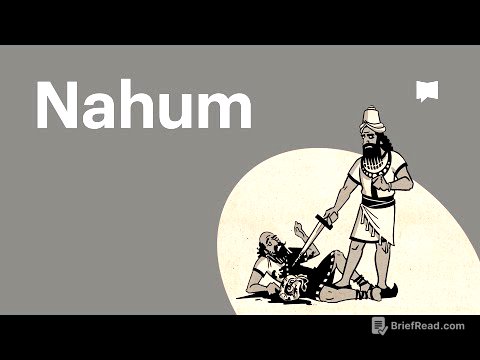TLDR;
This YouTube video by Utkarsh Classes provides a detailed overview of the Census 2011 of India and recent Current Affairs. The video begins with an introduction to the census, including its historical context and key figures. It then discusses various aspects of the 2011 census, such as population size, growth rate, sex ratio, literacy rate, and population distribution across states and union territories. The lecture includes mnemonics to remember facts. The video also covers current affairs, including the Nobel Prize in Medicine 2025, joint military exercises, and infrastructure projects.
- Census 2011 data including population, growth rate, and literacy.
- Key facts about states and union territories.
- Current affairs including Nobel Prize winners and international events.
Start [0:38]
The session starts with a motivational quote. The instructor welcomes everyone to the session, emphasizing that the topics covered are important for exams and will be revised repeatedly. The main topic for the day is the Census 2011, which is described as a crucial topic for all exams.
Census History and Basics [1:19]
The census in India began in 1872 during the time of Viceroy Mayo. The first census on a scientific and decennial basis started in 1881 under Viceroy Ripon. The officer in charge of conducting the census is called the Census Commissioner, and the first Census Commissioner of India was W.C. Plowden. The 2011 census is the 15th census in the series and the 7th since India's independence in 1947. The decade between 1911 and 1921 is known as the "Decade of Great Division" because the population decreased due to famine and epidemics.
2011 Census Details [3:14]
The 2011 census was the 15th in the series, with C. Chandramouli as the commissioner. The motto for the census was "Our Census, Our Future." According to the 2011 census, the population of India was 121.09 crore, second only to China at that time. The population growth rate from 1911 to 2001 was 21.54%, while the growth rate between 2001 and 2011 was 17.7%. The female population was 48.53%, and the male population was 51.47%.
Largest and Most Populous States [4:52]
Rajasthan is the largest state in terms of area, while Goa is the smallest. Among the Union Territories, Ladakh is the largest, and Lakshadweep is the smallest. Uttar Pradesh is the most populous state, accounting for 16.51% of India's population. Maharashtra ranks second, Bihar third, and West Bengal fourth in terms of population.
Minimum Population and Decadal Growth [6:16]
Sikkim has the lowest population, followed by Mizoram, Arunachal Pradesh, and Goa. Meghalaya has the highest decadal growth rate at 27.9%, compared to India's overall growth rate of 17.7%. Nagaland is the only state where the population growth rate was negative (-0.6%).
Population Density [8:26]
The population density of India, according to the 2011 census, is 382 persons per square kilometer. Bihar has the highest population density with 1106 persons per square kilometer, followed by West Bengal, Kerala, and Uttar Pradesh. Arunachal Pradesh has the lowest population density, with only 17 people per square kilometer. Delhi is the most populous Union Territory and has the highest population density in India, even higher than Bihar.
Sex Ratio [11:02]
The sex ratio in India, according to the 2011 census, is 943 females per 1000 males. Kerala has the highest sex ratio with 1084 females per 1000 males, making it the only state in India where the sex ratio is more than 1000. Haryana has the lowest sex ratio with 879 females per 1000 males. In terms of child sex ratio (0-6 years), Arunachal Pradesh tops the list with 972, while Haryana has the lowest with 834.
Literacy Rate [13:27]
The literacy rate in India, according to the final figures of the 2011 census, is 73%. The literacy rate for males is 80.09%, while for females, it is 64.60%. Kerala has the highest literacy rate at 94%, while Bihar has the lowest at 61.80%.
Rural and Urban Population [14:48]
Himachal Pradesh has the highest rural population, with 90% of its population living in villages. Goa has the highest urban population, with 62% of its population living in cities. Maharashtra has the largest urban population in terms of numbers, while Goa has the highest percentage of urban population.
SC and ST Population [16:35]
Uttar Pradesh has the highest Scheduled Caste (SC) population, approximately 5.25 crore. Punjab has the highest percentage of SC population, with about 31.9% of its population belonging to the SC category. Madhya Pradesh has the highest Scheduled Tribe (ST) population, approximately 1.5 crore. Mizoram has the highest percentage of ST population, with about 94% of its population belonging to the ST category.
Summary of Key Data [18:36]
Uttar Pradesh leads in overall population, while Sikkim has the lowest. Bihar has the highest population density, whereas Arunachal Pradesh has the lowest. Meghalaya has the highest population growth rate, and Nagaland has the lowest (negative). Kerala has the highest literacy rate, while Bihar has the lowest. In SC population, Uttar Pradesh leads in numbers, and Punjab leads in percentage. In ST population, Madhya Pradesh leads in numbers, and Mizoram leads in percentage. Kerala has the highest gender ratio, and Haryana has the lowest.
Current Affairs Introduction [22:46]
The instructor transitions to current affairs, starting with the announcement of the 2025 Nobel Prize in Medicine.
Nobel Prize in Medicine 2025 [25:21]
The Nobel Prize in Medicine 2025 has been awarded to three scientists: Mary Bruncombe, Fred Rumsel, and Simone Sakaguchi. Mary Bruncombe and Fred Rumsel are from the USA, while Simone Sakaguchi is from Japan. The prize was awarded for their discoveries concerning "peripheral immune tolerance," which involves the immune system's ability to not attack the body's own tissues. The instructor provides a mnemonic to remember the winners: "My friend Seema, give me the medicine."
Military Exercises and International Relations [34:36]
The video discusses the joint exercise Konkan 2025 between the Indian and British navies, which took place on the western coast of India. INS Vikrant participated in the exercise. Another exercise between India and England is Ajay Warrior. The video also mentions other military exercises involving India with different countries, such as sea power and Garuda Shakti with Indonesia, Maitri Shakti with Sri Lanka, and Aquarian and Unity with Maldives.
Mud Volcano in Andaman and Nicobar [39:10]
The only mud volcano in India, located in Andaman and Nicobar Islands on Bara Tatang Island, recently erupted after 20 years. The eruption is due to the decomposition of organic matter inside the earth, which turns into mud. The video also mentions Barren Island, the only active volcano in India, also located in the Andaman and Nicobar Islands. The new names of Havelock Island (Swaraj Island) and Ross Island (Bose Island) in Andaman and Nicobar are also discussed.
Recent Awards and Recognitions [43:14]
Educate Girls, an NGO from Rajasthan, won the 2025 Ramon Maxse Prize. Satvik and Chirag won the bronze medal at the BWF World Cup in Paris.
Infrastructure and Space Missions [44:22]
The Indian Army conducted combat skills and accurate strike practices in Arunachal Pradesh. NASA's Cassini spacecraft discovered new evidence of the possibility of life on Saturn's moon, Enceladus. The video provides details about the Cassini spacecraft, its mission to Saturn, and the characteristics of Enceladus, which has a thick layer of shiny ice around it.
Airport Name Changes and Other Updates [52:41]
The Navi Mumbai Airport has been renamed Loknet D Y Patil Airport. Pune Airport is now named after Saint Tukaram, and Chhatrapati Sambhaji Airport is now Chhatrapati Sambhaji Maharaj Airport. The video also mentions the Ramachandran Museum in Kerala.
BRO Constructs World's Highest Motorable Road [57:42]
The Border Roads Organisation (BRO) has constructed the world's highest motorable road in Ladakh at an altitude of 19,400 feet under Project Himank. The road connects Halle to Fukche and is near the Mig pass. The BRO was established on 7 May 1960, and it operates under the Ministry of Defence.
Commonwealth Parliamentary Conference [1:03:10]
The 68th Commonwealth Parliamentary Conference took place in Bridgetown, Barbados. Om Birla, the Speaker of the Lok Sabha in India, led the Indian delegation. The previous conference (67th) was held in New South Wales, Australia, and the first one was held in London in 1948.
Cooperative Project in Maharashtra [1:07:09]
India's first co-operatively operated Compressed Biogas and Potash Granule Project was inaugurated in Kopargaon, Maharashtra, by Amit Shah. The project aims to produce 12 tonnes of CBG gas and 75 tonnes of potash per day. Currently, India imports 100% of its CBG and potash.
World Para Athletics Championships 2025 [1:13:19]
The World Para Athletics Championships 2025 were held in New Delhi. Brazil topped the medal table, and India ranked 10th. India won a total of 22 medals, including 6 gold, 9 silver, and 7 bronze. Shailesh Kumar won India's first gold medal.
Book Release and Other Updates [1:17:20]
Senior journalist Harindra Baweja's memoir, "They Will Suit You Madam," was released. The book covers her reporting experiences, including the 1984 Operation Blue Star and the 26/11 Mumbai attack. The video also mentions that Prime Minister Modi announced the Tribal Village Vision 2030 and that the period from November 15, 2024, to November 15, 2025, will be celebrated as Tribal Pride Year.
Closing Remarks [1:25:16]
The instructor concludes the session, informing viewers about the availability of the current affairs magazine and upcoming classes. He encourages viewers to stay positive and keep learning.









